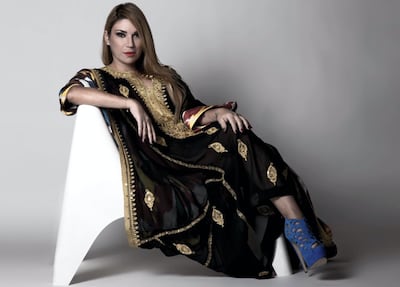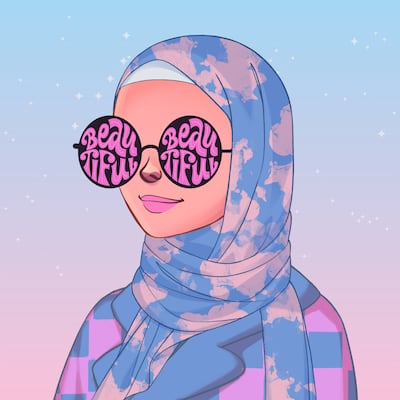Shurooq Amin picked up a paintbrush before she could even hold a pencil. But her burning passion for art has not made her journey to becoming a globally renowned artist an easy one.
The Kuwaiti artist, whose work is deemed provocative, has been censored throughout her career, for what she says is simply being an Arab Muslim woman.
This is what pushed her to seek out a world with no creative boundaries and delve into NFTs.
For International Women's Day, we take a look at how Amin and other creative females in the region are using this space to their advantage.
NFTs and censorship
The idea of creating art that could not be censored was particularly alluring for Amin, as her work often explores taboos and paradoxes that exist in modern-day Middle Eastern society.
In 2012, an exhibition she held in Kuwait City under the name It's a Man's World was shut down within three hours for including "inappropriate" content, as it depicted Arab men living double lives. The exhibition was her first to be closed down, despite coming after a similar collection called Society Girls, which portrayed Arab women as having hidden lives.
For weeks after the shutdown of It's a Man's World, Amin's morale was destroyed.
“It was traumatising, I stayed in bed for days,” she tells The National. “It was almost like they were telling me 'How dare you, an Arab Muslim woman, speak out about the patriarchy?'”

Despite the backlash, in 2013 Amin created the Popcornographic series, a 15-piece collection that explores the social taboos and conventional perceptions of being a Muslim Arab woman.
The name was inspired by an innocent slip of the tongue her daughter made when asking about why her artwork was being criticised.
“As soon as I heard my daughter ask me why people are saying my work is popcornographic, something clicked inside my head. I knew exactly what I had to do.”
Fast forward a few years and several cancelled shows later, Amin has compiled all her previously banned work into one NFT collection named Popcornographics.
“In this space, I can create without the fear of being silenced," she says. "It’s my way of putting my art out without any restrictions.”
Empowering women in the digital space
Now that she's embraced the NFT community, Amin is focusing her efforts on giving other creatives that same opportunity.
That’s how she crossed paths with Sharifa AlBarami, an Omani tech entrepreneur and angel investor with a similar mission.
Throughout her working experience with start-ups and entrepreneurs, AlBarami had always been interested in keeping up with emerging technologies that could disrupt sectors and improve the human experience.
“That’s exactly what NFTs do,” she says. “They have so much potential in so many fields.”
tech entrepreneur and angel investor
After doing extensive research, AlBarami realised that the decentralised blockchain technology can help bridge a huge gap in the creative world as it gives artists rightful ownership of the original work, making it easier for them to present, access or resell it. It also gives purchasers a guarantee that they are the owners of a one-of-a-kind digital asset.
“It’s revolutionary,” she says. “Creatives have rarely been able to really cash in on their talents, and now is their chance to do so.”
The desire to forgo the existing labour market structure and cultivate a space for creatives to capitalise on their skills is the leading force behind AlBarami’s work in the NFT community.
“We need more artists in the world,” she says. “We need more people to create and express themselves, and this is the perfect means to empower them.”
The collector hosts a weekly Twitter Space about NFTs in the Arab world, during which she breaks down the technology and guides potential joiners. The Space is held in Arabic and attracts more than 1,500 viewers and participants, with a notable presence of Arab women, including Amin.
“This is a telling sign of what’s to come,” she says. “Many young Arab women are eager to know more and understand this emerging technology, and they’re more than capable to jump right in and do wonders,” AlBarami said.
How NFTs can help achieve equality
Another promising NFT project led by a young Arab woman is Beyond Power.
Created at the beginning of December, it's a collection of about 10,000 illustrations or characters of women from different cultures and backgrounds, highlighting representation and diversity.
Beyond Power was founded by Raya Oklah, 29, a UI/UX designer from Jordan who has been working with NFTs full-time for the past five months.
“I quit my job to focus all my energy and potential on this, that’s how much I believe in NFTs and what they can do,” she says.
She started by creating a few characters, and later hired a team of designers to help her grow the collection.

The purpose of Beyond Power is to equalise opportunities for women in the Web3 era.
“Web2, or the internet we know and use today, is filled with gender disparities,” says Oklah. “It’s an uneven space, but Web3 will be different.”
Due to the centralised nature of Web2, decisions come from authorities that are most often male-dominated. This, according to Oklah, leaves no room for impact.
Meanwhile, the non-hierarchical structure of Web3 allows women to make their own rules.
“It’s a space that we can shape ourselves,” she tells The National. “And we’re going to carve it in a way that gives women equal opportunities.”
The Beyond Power collection, which is slated to launch in April, is made up of female characters wearing sunglasses with various empowering words on them.
“Powerful, fierce, hustler and more … these words are meant to serve as affirmations,” says Oklah. “We want every woman to look at our NFTs and see themselves in those characters.
“Because they are powerful, they are capable and they are going to make a change in this revolutionary space.”
How NFTs can impact identity
Despite being intangible, some NFT art pieces leave a discernible mark.
Such is the work of Nour Hage, a Lebanese fashion designer who ventured into the world of digital art in early 2021.

Her very first NFTs were portraits of three of the Arab world’s most powerful historic female figures: ancient Egyptian queen Nefertiti; Dido, the founder and queen of Carthage, a Phoenician city-state located in modern Tunisia; and Zenobia, queen of the Palmyrene Empire, located in modern Syria.
These sold within 24 hours.
“I was amazed,” she says. “I first worked on those pieces as a side project, but I knew I had to dedicate more time and effort then.”
Despite her brother’s pleas for her to get into NFTs in 2017, it wasn’t until last year that Hage really delved into the technology.
“It instantly clicked for me, I quickly became obsessed with them,” she says.
She put her digital art skills to use and created her second collection, an ode to her grandmother and the life she lived.
“My artwork in general is focused on documentation of experiences and transmission of memory from one generation to another, and this collection was no different,” says Hage.
“My grandmother truly led an intriguing life, she travelled places, collected objects and experienced so much, and I wanted to translate that through portraits of her over her lifetime using pieces of clothing she gave me.”

Despite the personal sentiment behind the pieces, Hage’s work was a success among collectors, several of whom minted their first NFTs from her collections.
“This just shows that being true to yourself, especially in such a new and supportive medium, can go a long way,” says Hage.
“It’s a very welcoming community, and not at all as terrifying as it seems. So for anyone who’s looking to join, do it. This is just the beginning.”





